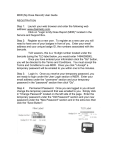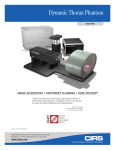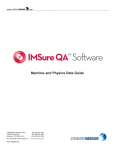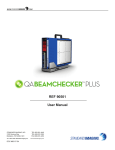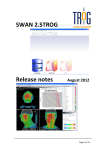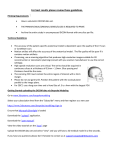Download REF 91250 - Standard Imaging
Transcript
WWW. .COM REF 91250 STANDARD IMAGING, INC. 3120 Deming Way Middleton, WI 53562-1461 TEL 800.261.4446 TEL 608.831.0025 FAX 608.831.2202 Oct / 2014 ©2014 Standard Imaging, Inc. DOC #80527-04 General Precautions WARNING: Follow manufacturer’s recommended safety procedures for radioactive sources. Warnings and Cautions alert users to dangerous conditions that can occur if instructions in the manual are not obeyed. Warnings are conditions that can cause injury to the operator, while Cautions can cause damage to the equipment. CAUTION: Do not drop or mishandle the slabs. CAUTION: Refer all servicing to qualified individuals. CAUTION: Proper use of this device depends on careful reading of all instructions and labels. 2 Table of Contents PAGE 2 General Precautions 3 Overview 6 General Operation 7 Optional SRS Dosimetric QA Slab 8 CyberKnife® Sample Dosimetry Tests 10 Ion Chamber Configuration 13 TPS Commissioning and Dose Conformality Testing 15 Film Dosimetry 17 SDVP Heterogeneity Insert 18 Maintenance 18 Parts and Accessories 19 Features and Specifications 3120 DEMING WAY MIDDLETON, WI 53562-1461 USA WWW.STANDARDIMAGING.COM Overview The Stereotactic Dose Verification Phantom can be used for a wide variety of tests including routine absolute dosimetry output checks and treatment planning system(TPS) commissioning and quality assurance(QA) tests as recommended by TG 53 and IEC 430 Treatment Planning System Commissioning and QA Standards. Patient specific dosimetry tests can be performed easily as well. The fixed portion of the phantom consists of the top and bottom 4 cm slabs that contain: •Gold fiducials for positioning setup accuracy, •Lead BBs diameter 1 mm at known precision manufactured locations on three corners so that superior – inferior, left – right, anterior – posterior and diagonal geometric distances can be confirmed in the imported patient CT studies thus demonstrating that no distortion is evident. The bottom slab has two rigid alignment posts that ensure all phantom configurations are precisely and reproducibly aligned, for every insert used with the phantom. Additional large Blue Water blocks are available so that the 20 x 20 x 10 cm dimension can be increased to a 30 x 20 x 20 cm. 2 BBs shown overlapped lead BB gold fiducials gold fiducials lead BB Front View lead BB 2 BBs shown overlapped gold fiducials lead BB Top View (larger marks indicate marker located in top slab) 3 Overview Continued Center Slab Configuration Details Two standard configurations of the 2.0 cm thick center slab accommodate an ion chamber or film. The Heterogeneity Insert and SRS Dosimetric QA Slab provide additional options. Ion Chamber Configuration The Ion Chamber Configuration consists of a 2 cm slab with interchangable 5/8” diameter plugs drilled to accept an ion chamber of choice. The centroid of the chamber’s collecting volume coincides with the center of the slab and can be identified radiographically with the center of mass of the embedded gold markers. Additional plugs for other thimble ion chambers or diodes are available. Ion Chamber Configuration for dose measurements Film Configuration The Film Configuration consists of two 5 mm slabs and five 2 mm slabs. The 2 mm slabs are machined to precisely position film cut to dimensions of 63.5 mm x 63.5 mm (2.500” x 2.500”, ± 0.007"); this stack of five 2 mm slabs is positioned between the 5 mm slabs. The recessed pocket in each slab accomodates the thickness of the GAF film. Film Configuration for patient specific or treatment plan dose verification NOTE: It is advised to mark each individual film for identification and orientation purposes to avoid mistakes during assembly and disassembly of the phantom. 4 Overview Continued SDVP Heterogeneity Insert Configuration (Optional, REF 72313) The SDVP Heterogeneity Insert consists of two 5 cm slabs of lung-equivalent material, and one 2 cm chamber slab. The chamber slab is placed between the two thicker lung slabs, and the entire lung-equivalent assembly is then placed between two standard Blue Water SDVP end slabs. The chamber plug with gold markers for the SDVP Heterogeneity Insert is made of Blue Water, and is designed to simulate a small tumor within the lung equivalent material. The SDVP Heterogeneity Insert is used with an ion chamber or other small detector to perform small field tests in a highly heterogeneous environment. Heterogeneity Insert Configuration for small field tests in a highly heterogenous environment SRS Dosimetric QA Slab Configuration (Optional, REF 70650) The SRS Dosimetric QA Slab is available as an accessory which provides a third option for the center slab. It contains targets which test treatment planning and CT number accuracy. Used in conjunction with the ion chamber and film configurations, the SRS Dosimetric QA Slab tests the accuracy of the TPS planned dose delivery. More information is available in the Optional SRS Dosimetric QA Slab section on page 6 of this manual. Optional SRS Dosimetric QA Slab (REF 70650) 5 General Operation The Stereotactic Dose Verification Phantom is easily set up for single beam dose output tests, as well as treatment plan delivery dose verification tests for a number of tracking methods. 1. G e n e r a l P h a n t o m S e t u p a n d Assembly. The alignment posts of the phantom do not allow accidental incorrect assembly of the phantom slabs. Rotated or inverted slabs are visually apparent. This is critical for the repeatability of assembly, as well as ensuring the embedded gold markers are in their correct orientation at all times. An alignment mark ( similar to a dimple) is located in the corner of each slab for use as a quick visual guide. Orient each slab with this mark facing upward and directly over the mark on the previous slab. Once assembled, thread the desired screws into the alignment posts until firm – do not over tighten! 2. Scanning the phantom with CT imager. Arrange the assembled Stereotactic Dose Verification Phantom on the CT table and align appropriately. Use the same scan parameters as for a typical patient to scan the phantom. 3. Position the phantom on the treatment couch. Position the Stereotactic Dose Verification Phantom on the treatment table and properly align to the alignment lasers. Image the phantom to confirm that the phantom position matches the planning CT position. 4. Treat the phantom. Treat the phantom as required to test the dosimetry and imaging functions of the specific TPS to be evaluated. nylon screws SRS Dosimetric QA Slab Configuration (Optional) SDVP Heterogeneity Insert Configuration thumb screws Film Configuration Ion Chamber Configuration Four methods of Stereotactic Dose Verification Phantom assembly 6 SRS Dosimetric QA Slab The SRS (Stereotactic Radiosurgery) Dosimetric QA Slab consists of three main components: air pocket, core target shapes, and CT density plugs. See material specifications section on page 18. Air Pocket The air pocket is used to test the dose calculation accuracy. Core Target Shapes The core target shapes, with their corresponding avoidance structures, are used to test complex dose delivery plans and a relative dose shape against objects of known dimension. The 6 x 6 cm core insert containing the shapes can be removed to be re-orientated in the slab for additional positioning. (See dimensions below.) Thickness of all shapes is 20.0 mm. CT Density Plugs (3 total) From left to right: Adipose, Cortical Bone, and Trabecular Bone. Thickness of all plugs is 20.0 mm. Alignment Mark SRS Dosimetric QA Slab R 3.18 mm 7.11 mm 2.11 mm Ø 6.0 mm Ø 20.0 mm 31.75 mm Ø 6.0 mm Ø 10.0 mm Ø 20.0 mm Core Target Shape Dimensions (not drawn to scale) 7 CyberKnife® Sample Dosimetry Tests The following section describes the steps required to perform: • Absolute Dose Traceability where a simple multibeam isocentric forward plan is generated to the Stereotactic Dose Verification Phantom Ion Chamber Configuration (see page 4). • Collimator Output Dose Delivery Verification is done using the smallest micro chamber in the ion chamber configuration. For example, using the 5 mm collimator with the output factor of 0.7, an inversely planned conformal plan is generated to an Exradin Micro Chamber with an expected dose of 10 Gy. The measured nC delivered to the phantom versus expected nC from the treatment plan should be within 5%. • Treatment Planning and Dose Delivery Conformality and Dosimetric Accuracy Highly conformal plans are generated using the optional SRS Dosimetric QA Slab Configuration (see page 4) which contains the complex shape used for planning. After import of the plan into the CyberKnife delivery system, the plan is delivered to the Film Configuration (see page 4). A fiducial plan guarantees sub-millimeter positioning accuracy of the film since the fiducials are embedded in the top and bottom portion of the phantom. The resulting film can be placed directly on the conformality shape of the SRS Dosimetric QA Slab for a qualitative check of the actual delivered dose shape relative to the actual complex shape that was planned. If film dosimetry such as a calibrated RIT system is available, prescribed versus measured actual dose can also be verified from the film, as well as the Distance to Agreement(DTA) values. If desired, the highly conformal plan can also be treated to the Ion Chamber Configura- CyberKnife® is a registered trademark of Accuray Incorporated. tion for an absolute dose delivered verification. • Patient Specific Dosimetry is done using the MultiPlan patient overlay function to generate a copy of the patient plan onto either the 1) Ion Chamber Configuration or the 2) Film Configuration. Complex film dosimetry is not required because the measured film isodoses can be physically placed on the expected TPS isodoses for a quick qualitative check of the Rx isodose line, as well as the 90, 50, and 10 percent lines. TPS Commissioning Test Examples The CT studies of the SRS Dosimetric QA Slab Configuration can be used to confirm geometric and CT density number accuracy on the imported studies. Contour volume size of the complex shapes embedded in the SRS Dosimetric QA Slab can be used to test the volumetric accuracy of the TPS software. Single beam dosimetry can be validated using the provided air cavity. General Test Flow CT images are acquired of each phantom configuration in one of two orientations depending upon the test to be conducted. Refer to Table 1: Dosimetry Test Description Summary. The general test work flow includes: •CT study acquisition •Import CT image sets as patient studies •Treatment plans generation •Import as patient treatments on the CyberKnife SGI Treatment Delivery System •Generate the DRRs and confirm the prescription •Setup and treat the phantom •Compare measured results with the expected values. 8 CyberKnife® Sample Dosimetry Tests Continued CT Setup Phantom Configuration Test Description TPS Plan Method Ion Chamber Configuration (Page 10) A. Absolute Dose Calibration Traceability A. Model A19 Exradin Classic Farmer-type or other Farmer-type Chamber in the coronal plane Forward isocentric plan with the 60 mm collimator to 10 Gy. Select a fiducial plan delivery. From the nC measured for 10Gy to a single beam, deliver multi beam plan to the chamber. Results should be within 2% of expected. B. B. Exradin Micro Chamber or other micro thimble in the coronal plane Inverse conformal plan to the selected micro chamber using the 5 mm collimator and 80 cm SAD Collimator Dose Delivery Confirmation Using a Micro Chamber TPS Commissioning and Dose Conformality Testing (Page 13) A. B. C. D. TPS Geometric Accuracy CT Density Model Single Beam Dose Calculation Tests Dose Conformality with Complex Shapes 1) C shape 2) Avoidance 6 mm Cylinders or Trigeminal Target 3) Tentacle Place SRS Dosimetric QA Slab onto the alignment 4 cm slabs. Scan in both the transverse and coronal orientation. C. Add additional solid water blocks to achieve depth required for single beam dosimetry QA Inverse planning A. When imported into the TPS, use the graphical user interface ruler to confirm the distances between the lead BBs. B. Measure CT numbers on the CT unit, then measure on the imported study to confirm that the CT density model that you have entered into the MultiPlan TPS are in agreement. C. Select the AQA path set to perform single beam dosimetry tests from either the AP or LAT beam position D. Generate highly conformal plans at each SAD Film Dosimetry (Page 15) A. Conformal Relative Dose Delivery Accuracy Place the Film Insert onto the bottom 4 cm slab alignment pins. Scan in both the coronal and transverse plane, i.e. the film in parallel to the CT table(coronal) and also parallel with the CT slice(transverse). Plans generated to the Dosimetric QA phantom are delivered to the Film Phantom. The film is scanned to the Rx isodose line(IDL), and over lain directly onto the conformal shape that was planned. B. Patient Dose Overlay Test (Example using Radiological Physics Center Dose Phantom) Scan the Radiological Physics Center CyberKnife SRS phantom as instructed. Using the MultiPlan overlay function to copy the desired treatment plan onto the Dose Film Phantom Table 1: Dosimetry Test Description Summary 9 Ion Chamber Configuration Configuration for CT Scanning The Stereotactic Dose Verification Phantom is comprised of rectangular slabs of waterequivalent material which are precisely stacked together with two guideposts and either flat-topped or thumb screws. It is designed to accommodate many types of ion chambers or diodes. Four embedded gold fiducial markers provide positioning accuracy similar to the implanted fiducials used for patient alignment. All phantom configurations are scanned according to the Accuray treatment planning system requirements. Use a Field of View that fully encompasses the phantom, slice thicknesses of less than 1 tilt mm, and 120 kVp. The mA can be adjusted so that a reasonable grey scale range is obtained. If helical acquisition is used, choose the lowest pitch value possible. Ion Chamber Configuration A. Absolute Dose Calibration Traceability The absolute dose insert houses plugs that are machined to accommodate most types and sizes of ionization chambers or diodes. Typically the Farmer-type Chamber used to calibrate the linear accelerator is also used for the absolute dose traceability test. The chamber insert, depicted in Image 1, shows how the dose chambers and diodes are volumetrically centered to the geometric center of the phantom. NOTE: The chamber location geometry is for convenience only, and allows use of the phantom with many treatment planning systems and linear accelerators. By rearranging the 4 cm slabs, monthly output checks can be done with this phantom. 2 1 3 4 Image 1: Coronal View of the Model A19 Exradin Classic Farmer-type Chamber in the Ion Chamber Configuration of the Stereotactic Dose Verification Phantom • • • Dots at the outer corners indicate the 1 mm BB positions to confirm the geometric accuracy of the imported CT study. Positions numbered 1 through 4 indicate the gold fiducial positions for image alignment during treatment delivery to the phantom. The Model A19 Exradin Classic Farmer-type Chamber volume is positioned at the geometric center of the phantom 10 Ion Chamber Configuration Continued Absolute dose calibration verification treatment plan Refer to Image 2 below with the Model A19 Exradin Classic Farmer-type ion chamber showing the precision placement of the four gold fiducials. Many types of chambers or diodes can be used with this insert using custom made plugs per request. Contact Standard Imaging regarding availability. Use an expansion of the FB volume to ensure that the active volume 97% dose cloud covers the active volume. Select 80 cm SAD and the 60 mm collimator used for the absolute dose calibration of the CyberKnife. Image 2: Software image showing the Model A19 Exradin Classic Farmer-type Chamber and gold fiducial placement Software screenshots used with permission of Accuray Incorporated. 11 Ion Chamber Configuration Continued B. Collimator Dose Delivery Confirmation Using a Micro Chamber For the collimator dose delivery confirmation test, the smallest micro chamber is used. Image 3: Model A16 Exradin Micro Chamber in the Ion Chamber Configuration Collimator Dose Delivery Test Generate a conformal plan to the micro chamber using the trigeminal path set at 80 cm SAD. An nCI(new conformality index) of less than 1.5 should be achievable. Image 4: Collimator Dose Delivery Accuracy Inverse Conformal Plan to a Model A16 Exradin Micro Chamber with 5 mm collimator. 80 cm SAD is recommended if trigeminal cases are to be done. 12 TPS Commissioning and Dose Conformality Testing A. TPS Geometric Accuracy The left – right and superior – inferior distance is 180 mm, while the anterior – posterior distance is 80 mm. The diagonal distance can be calculated as well to verify that the CT studies are imported without geometric distortion. Use the graphical ruler from the global tools on the right side of the CyberKnife software interface. See page 21 for dimension information. B. CT Density Model Left mouse click on the CT plugs to compare with the CT numbers measured on your local CT scanner where the SRS Dosimetric QA Slab Configured Phantom was scanned. C. Single Beam Dose Calculation Tests Image 5: SRS Dosimetric QA Slab shown within its Stereotactic Dose Verification Phantom configuration and independently Use the AQA path to place a single beam on the SRS Dosimetric QA Slab Configured Phantom. The Physics Essentials manual supplied by Accuray contains detailed steps for single beam dosimetry analysis. 13 TPS Commissioning and Dose Conformality Testing Cont. D. Dose Conformality with Complex Shapes Several complex shapes are included in the SRS Dosimetric QA Slab. See page 7 for shape dimensioning and material information. 1) C Shape 2) Avoidance 6.0 mm Cylinders or Trigeminal Target 3) Tentacle For example, a conformal plan is displayed to the C Shape in Image 6 where the 6.0 mm cylinder was treated as an avoidance object. The opposite can also be easily done using the 6.0 mm cylinder as a trigeminal object using the C Shape as the avoidance structure. When testing conformality, use the appropriate range of SADs and collimator sizes. Once a plan similar to Image 6 is generated, import it into the SGI treatment delivery system, generate the DRRs for patient(phantom) setup, confirm the prescription, and deliver the plan to the phantom in the Film Configuration. The resulting film can be scanned at the prescription isodose line, and the 90%, 50%, and 20% lines relative to the point of maximum dose. Conformality of the dose delivered relative to the expected isodose lines can be evaluated. The film dose plot can be directly placed on the phantom for a qualitative relative dose analysis. If dose analysis software is available, the DTA between planned and measured doses can be determined, as well as the isodose level agreement. Image 6: Software image showing a conformal plan to the C Shape 14 Film Dosimetry Film Dosimetry The Film Configuration is comprised of two slabs of 5 mm thickness plus five slabs of 2 mm thickness that have a recessed pocket to contain GAF film in a precise geometry relative to the phantom and the embedded gold fiducials. Either conformality test plans generated using the SRS Dosimetric QA Slab Configured Phantom, or patient overlay treatments are delivered to this phantom. The film insert and the fiducials allow precision placement of the phantom so that the expected plan relative and absolute dose is automatically aligned within the phantom. Image 7: Stereotactic Dose Verification Phantom shown in the Film Configuration A. Conformal Relative Dose Delivery Accuracy A plan is generated to one of the complex shapes contained in the SRS Dosimetric QA Slab. The treatment is delivered to the Film Configured Phantom which is substituted for the SRS Dosimetric QA Slab Configured Phantom. The resulting film may then be scanned and the prescription isodose plotted. If the prescription isodose line is scaled to true dimension and then plotted, the plot can be physically overlain on the actual object for which the plan was generated. The plot of the prescription isodose and the complex shape should match within 1 mm of the approved isodose cloud encompassing the object for which the plan was generated and treated. (See Image 9) Image 8: 2 mm thick slab with recessed pocket to hold GAF film B. Patient Dose Overlay Test — Uses either the Film or Ion Chamber Configuration for dose measurements 15 Film Dosimetry Continued Any treatment plan generated using the SRS Dosimetric QA Slab Configured Phantom can be delivered to the Film Configured Phantom without using the overlay function. If patient specific QA is to be done: Film Configured Phantom to evaluate the relative isodose distribution of the plan for the example phantom depicted below in comparison with the distribution delivered to the Film Configured Phantom. 1. 2. 3. NOTE: The BODY treatment delivery selection must be made to deliver a fiducial treatment. The phantom needs to be placed AWAY from the head end of the table, and placed in a CHEST position to avoid collisions. Select the phantom overlay function Select the film phantom Select the patient plan that you wish to treat to the film DV phantom An example phantom is depicted in Image 9 below. The plan can be delivered to the Image 9: An example phantom adapted for Fiducial Treatment Delivery. 16 SDVP Heterogeneity Insert SDVP Heterogeneity Insert The SDVP Heterogeneity Insert is used with an ion chamber or other small detector to perform small field tests in a highly heterogeneous environment. Extended guideposts are provided to assemble and align this configuration, and radio opaque alignment markers are present in both the chamber slab and the chamber plug. Lung treatment planning and delivery may be tested using the following steps: 1. Acquire CT Images. Assemble the SDVP Heterogeneity Insert Configuration and acquire CT images. Note the fiducial markers located in both the lung and standard SDVP slabs as well as the chamber plug. Ensure that the chamber plug rotational orientation mark is aligned with the corresponding mark on the chamber slab. 2. Create treatment plan. Use the CT images to create a treatment plan and establish expected results. 3. Align on treatment couch. Place the phantom on the treatment couch and align with room coordinates. Insert the ion chamber into the plug, and the plug into the (middle) chamber slab. Ensure that the chamber plug is aligned as in step (1). Align the phantom initially using lasers or beam crosshairs. Adjust alignment of the phantom using image guidance if desired. For gated treatments, the phantom may be placed on a motion platform. 4. Acquire measurement with ion chamber or other small detector. Deliver the treatment plan to the phantom and acquire measurements with the ionization chamber. 5. Compare the measurement data with expected results. Image 10: Heterogeneity Insert Configuration Image 11: Location of markers within Heterogeneity Insert Configuration NOTE: Handle lung slabs with care. Lung material is soft and can be easily scratched or deformed with misuse. 17 Maintenance Exterior cleaning of the device can be done with a soft brush and a cloth. Gently brush all surfaces to remove dirt and dust. Remove any remaining dirt with a cloth slightly dampened with a solution of mild detergent and water or a liquid disinfecting agent. Calibration is not required. There are no serviceable parts on the Stereotactic Dose Verification Phantom. If assistance is desired in the proper disposal or recycling of this product (including accessories and components), after its useful life, please return to Standard Imaging. Parts and Accessories REF Description 70650 71202 72313 72771 SRS Dosimetric QA Slab SDVP 91250 Plug with cavity drilled for ion chamber of choice Stereotactic Dose Verification Phantom Heterogeneity Insert Heterogeneity Insert 72313 Plug with gold markers and cavity drilled for ion chamber of choice 92726 92746 92739 92722 92723 92749 92700 92734 Exradin A16 Ion Chamber, MicroPoint, 0.007 cc Exradin A26 Ion Chamber, MicroPoint, 0.015 cc Exradin W1 Scintillator Exradin A1SL Ion Chamber, Slimline Miniature Shonka, 0.053 cc Exradin A14SL Ion Chamber, Slimline MicroChamber, 0.015 cc Exradin A28 Ion Chamber, Scanning, 0.125 cc Exradin A12 Ion Chamber, Farmer-type Chamber, 0.64 cc Exradin A19 Ion Chamber, Classic Farmer-type, 0.62 cc 90015 90018 70004 MAX 4000 Electrometer SuperMAX Electrometer Extension Cable (available lengths: 1, 3, 6, 10, 15, 20, 25, 30 m or custom length) 18 Features and Specifications Assembled Phantom Dimensions Height Width Length Weight Complete Stereotactic Dose Verification Phantom (ion chamber or film configuration) SRS Dosimetric QA Slab only 10.00 cm (3.94 in.) 20.00 cm (7.87 in.) 20.00 cm (7.87 in.) 4.4 kg (9.7 lbs.) 0.9 kg (2.0 lbs.) Core Target Shape Volume "Tentacle" Shape 9.86 cm3 "C" Shape 2.38 cm3 "Avoidance Structure" Shape 0.56 cm3 Included Components (1) (1) (1) (2) (1) (2) (5) (2) (1) (1) Bottom slab with imbedded gold markers, lead BBs, and integral alignment posts Top slab with imbedded gold markers and lead BBs 2.0 cm chamber slab with generic cavity hole Ion chamber plugs (drilled for Model A19 Exradin Classic Farmer-type Chamber and Model A16 Exradin Micro Chamber) Blank chamber plug 5.0 mm slabs 2.0 mm slabs with recessed pockets to accept 63.5 mm x 63.5 mm (2.500" x 2.500") film Flathead nylon 6/6 screws Flathead screwdriver User Manual See www.standardimaging.com for applicable tech notes. Specifications are subject to change without notice. 19 Features and Specifications Continued Material Densities Main Phantom Components Physical Density [g/cc] Nominal CT value [HU] Blue Water plastic 1.09 70 Black delrin alignment posts and thumbscrews 1.43 355 Nylon 6/6 flathead screws 1.14 100 Physical Density [g/cc] Nominal CT value [HU]* Electron Density per cc x 1023 Relative Electron Density to Water Blue Water plastic 1.09 70 3.524 1.055 Black C552 target shapes 1.76 600 5.321 1.593 SRS Dosimetric QA Slab Cortical bone plug 1.91 1500 5.952 1.782 Trabecular bone plug 1.20 300 3.863 1.157 Adipose plug 0.94 -60 3.102 0.929 Physical Density [g/cc] Nominal CT value [HU]* Electron Density per cc x 1023 Relative Electron Density to Water S.D.V.P. Heterogeneity Insert Blue Water plastic 1.09 70 3.524 1.055 Lung 0.280 -700 0.865 0.259 * HU Values may differ from those shown here, since these values are dependent on the CT scanner, scanner calibration, imaging protocol, and image reconstruction technique. See www.standardimaging.com for applicable tech notes. Specifications are subject to change without notice. 20 Features and Specifications Continued 10.0 mm TYP 30.0 mm 10.0 mm 100.0 mm 5.0 mm TYP 80.0 mm 10.0 mm 30.0 mm 50.0 mm 40.0 mm 50.0 mm 40.0 mm 200.0 mm 180.0 mm 40.0 mm 50.0 mm 40.0 mm 50.0 mm 180.0 mm 200.0 mm Dimensioned locations of the gold markers and BBs embedded within the phantom See www.standardimaging.com for applicable tech notes. Specifications are subject to change without notice. 21 Features and Specifications Continued Dimensioned locations of the gold markers and BBs embedded within the SDVP Heterogeneity Insert See www.standardimaging.com for applicable tech notes. Specifications are subject to change without notice. 22 Notes 23 Notes 24 Service Policy Return Policy If service, including recalibration, is required, please contact Standard Imaging’s Customer Service department by phone or email prior to shipping the product. Standard Imaging’s Customer Service and Technical Service staff will attempt to address the product issue via phone or email. If unable to address the issue, a return material authorization (RMA) number will be issued. With the RMA number, the product can be returned to Standard Imaging. It is the responsibility of the customer to properly package, insure and ship the product, with the RMA number clearly identified on the outside of the package. The customer must immediately file a claim with their carrier for any shipping damage or lost shipments. Return shipping and insurance is to be pre-paid or billed to the customer, and the customer may request a specific shipper. Items found to be out of warranty are subject to a minimum service fee of 1 hour labor (excluding recalibrations) for diagnostic efforts and require a purchase order (PO) before service is performed. With concurrence from customer, the product may be replaced if it is unserviceable or if the required service is cost prohibitive. Products incurring service charges may be held for payment. Standard Imaging does not provide loaner products. See the Standard Imaging Warranty and Customer Responsibility for additional information. No merchandise will be accepted for credit without prior approval of return. Please contact Standard Imaging’s Customer Service Department to receive a return authorization number before returning any merchandise for exchange or credit. Products manufactured by Standard Imaging must be returned within thirty days of receipt of order in ‘like new’ condition. No credit will be given for products returned after thirty days from receipt of order. A minimum twenty percent restocking fee will be charged on all returned merchandise. All materials returned must be shipped pre-paid. Credit for returned goods will be issued to customer's account for use against future purchases of merchandise only. Special orders, custom products, re-sale (not manufactured by Standard Imaging) products, and ADCL calibrations will not be accepted for return credit or exchange. Serialization Information Standard Imaging products that are serialized contain coded logic in the serial number which indicates the product, day and year of manufacture, and a sequential unit number for identification: A YY DDD X A YY Unique product ID (if applicable) Last two digits of the year (e.g. 1999 = 99, 2000 = 00) DDD Day of the year (1< DDD < 365) X Unique unit ID Number (1 < X < 9) 25 Customer Responsibility This product and its components will perform properly and reliably only when operated and maintained in accordance with the instructions contained in this manual and accompanying labels. A defective device should not be used. Parts which may be broken or missing or are clearly worn, distorted or contaminated should be replaced immediately with genuine replacement parts manufactured by or made available from Standard Imaging Inc. CAUTION: Federal law in the U.S.A. and Canadian law restrict the sale, distribution, or use of this product to, by, or on the order of a licensed medical practitioner. The use of this product should be restricted to the supervision of a qualified medical physicist. Measurement of high activity radioactive sources is potentially hazardous and should be performed by qualified personnel. Should repair or replacement of this product become necessary after the warranty period, the customer should seek advice from Standard Imaging Inc. prior to such repair or replacement. If this product is in need of repair, it should not be used until all repairs have been made and the product is functioning properly and ready for use. After repair, the product may need to be calibrated. The owner of this product has sole responsibility for any malfunction resulting from abuse, improper use or maintenance, or repair by anyone other than Standard Imaging Inc. The information in this manual is subject to change without notice. No part of this manual may be copied or reproduced in any form or by any means without prior written consent of Standard Imaging Inc. CAUTION: As desired by IAEA, English is the default language for labeling and manuals. If translated versions are available, resolve any differences in favor of the English versions. WARNING: Proper use of this device depends on careful reading of all instructions and labels. WARNING: Where applicable, Standard Imaging products are designed to be used with the versions of common radiation delivery devices, treatment planning systems and other products or systems used in the delivery of ionizing radiation, available at the time the Standard Imaging product is released. Standard Imaging does not assume responsibility, liability and/or warrant against, problems with the use, reliability, safety or effectiveness that arise due to the evolution, updates or changes to these products or systems in the future. It is the responsibility of the customer or user to determine if the Standard Imaging product can be properly used with these products or systems. 26 Warranty Standard Imaging, Inc. sells this product under the warranty herein set forth. The warranty is extended only to the buyer purchasing the product directly from Standard Imaging, Inc. or as a new product from an authorized dealer or distributor of Standard Imaging, Inc. For a period provided in the table below from the date of original delivery to the purchaser or a distributor, this Standard Imaging, Inc. product, provided in the table is warranted against functional defects in design, materials and workmanship, provided it is properly operated under conditions of normal use, and that repairs and replacements are made in accordance herewith. The foregoing warranty shall not apply to normal wear and tear, or if the product has been altered, disassembled or repaired other than by Standard Imaging, Inc. or if the product has been subject to abuse, misuse, negligence or accident. Product Warranty Period Standard Imaging Ionization Chambers 2 years Standard Imaging Well Chambers 2 years Standard Imaging Electrometers 5 years Standard Imaging BeamChecker Products 2 years Standard Imaging Software Products 1 year All Other Standard Imaging Products 1 year Standard Imaging Custom Products 1 year Standard Imaging Remanufactured Products 180 days Standard Imaging Custom Select Products 90 days Consumables 90 days Serviced Product 90 days Resale Products As defined by the Original Equipment Manufacturer ADCL Product Calibration (Standard Imaging uses the UW-ADCL for recalibrations required under warranty, unless otherwise requested) 0 - 90 days = 100% of ADCL Calibration Costs 91 - 182 days = 75% of ADCL Calibration Costs 183 – 365 days = 50% of ADCL Calibration Costs 366 – 639 days = 25% of ADCL Calibration Costs (days from date of shipment to customer) Standard Imaging’s sole and exclusive obligation and the purchaser’s sole and exclusive remedy under the above warranties are, at Standard Imaging’s option, limited to repairing, replacing free of charge or revising labeling and manual content on, a product: (1) which contains a defect covered by the above warranties; (2) which are reported to Standard Imaging, Inc. not later than seven (7) days after the expiration date of the warranty period in the table; (3) which are returned to Standard Imaging, Inc. promptly after discovery of the defect; and (4) which are found to be defective upon examination by Standard Imaging Inc. Transportation related charges, (including, but not limited to shipping, customs, tariffs, taxes, and brokerage fees) to Standard Imaging are the buyer’s responsibility. This warranty extends to every part of the product excluding consumables (fuses, batteries, or glass breakage) or material reactions. Standard Imaging, Inc. shall not be otherwise liable for any damages, including but not limited to, incidental damages, consequential damages, or special damages. Repaired or replaced products are warranted for the balance of the original warranty period, or at least 90 days. This warranty is in lieu of all other warranties, express or implied, whether statutory or otherwise, including any implied warranty of fitness for a particular purpose. In no event shall Standard Imaging, Inc. be liable for any incidental or consequential damages resulting from the use, misuse or abuse of the product or caused by any defect, failure, malfunction or material reactions of the product, whether a claim of such damages is based upon the warranty, contract, negligence, or otherwise. This warranty represents the current standard warranty of Standard Imaging, Inc. Please refer to the labeling or instruction manual of your Standard Imaging, Inc. product or the Standard Imaging, Inc. web page for any warranty conditions unique to the product. 27



























